Home › Forums › Bows and Equipment › Dave's bull — Ashby performance report
-
AuthorPosts
-
-
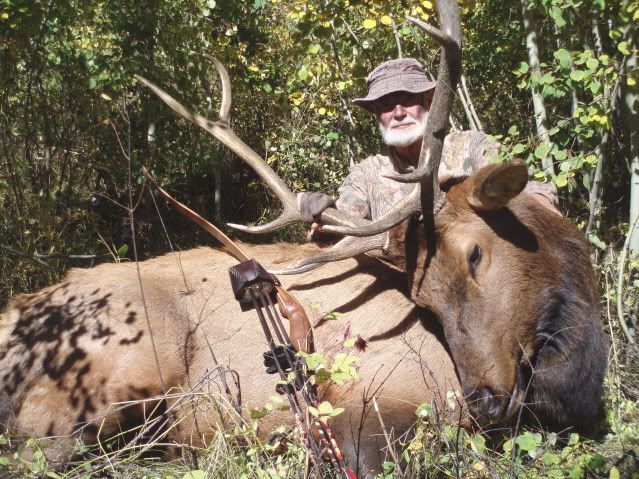 Here’s the end product (and a good example of a clean, respectful “hero” photo: no excessive blood or projecting arrow, tongue not hanging out and hunter posed respectfully rather than a “rodeo cowboy” sitting on animal in triumph.)
Here’s the end product (and a good example of a clean, respectful “hero” photo: no excessive blood or projecting arrow, tongue not hanging out and hunter posed respectfully rather than a “rodeo cowboy” sitting on animal in triumph.)I shot this bull, above, from just 6′ as he whirled to run when I drew. Setup was Carbon Express shaft with Abowyer Brown Bear head, brass shaft insert and steel broadhead adapter, total weight 680 grains with 26%+ FoC. Bow is Shrew Classic Hunter, 55# at 28″. Arrow struck midchest and got only about 8″ penetration — a combo of “whirling effect” of the bull at impact and mostly, a rushed snap shot that was well short of full draw. (I swear, no matter how I try to get it right and beat myself up when I don’t, I will always be susceptible to “buck fever” judgment errors like this, given proper pressures — like a bull standing right over you on the last day of the season!) Arrow flopped several times as bull ran off, then the insert pulled out of the shaft and the arrow fell out leaving head and insert inside the lung. This next photo shows what that combo — shaft flopping around and head staying in — did to the lung. Neither my hunting pal T. Downing nor I have ever seen anything like it before, with rifle or bow, looked like a blob of lumpy Jello. While the bull didn’t lead a drop of blood externally, his chest cavity was full of it. “You could drown in that amount of blood,” as my observation. Note also the small knife. According to Murphy’s law I’d forgotten my belt and belt knife that morning and had to do the entire job with this little Helle. 3.5″ blade is fine but the tiny handle left my hands cramped.

Here’s the entrance hole made by the Brown Bear — huge, with a blown-apart rib strike. (I couldn’t find the head in the bloody mess and need to return to the scene once the scavengers are done to find it. I expect no tip damage.)

As promised to Ed Ashby, I took a couple of test shots on the dead animal using different heads. Most telling was a 15 yard shot purposely at a 45-degree angle into the top, heaviest portion of the right scapula. The ABS Ashby head didn’t crack the bone but it sure wedged a big hole in it — which is the idea, in order to free friction and allow deeper penetration. Even with this heavy bone impact the arrow got 18″ penetration and no damage whatsoever to the head. Next pic is the inside of the scapula, showing the large “hinge” of bone blown out by the Ashby head.

Finally, I used a Tusker Concord for a 10 yard broadside shot attempting to hit the heart. This shot missed ribs on entrance and penetrated to the nock (backed out a bit in the following photo), stopped on the other side by the ground.
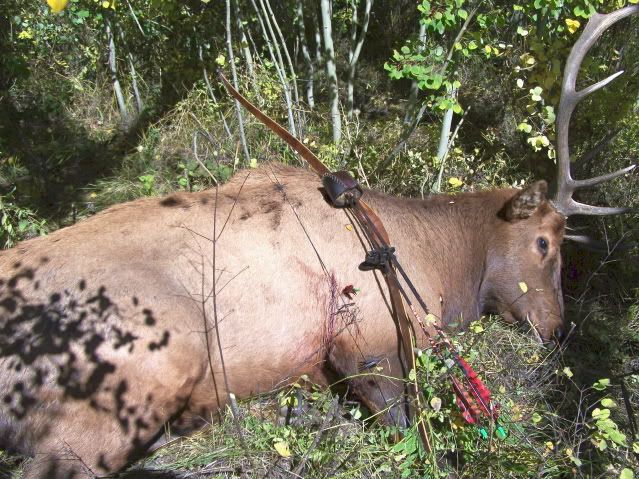
Summary: Here, as with Steve Sr., Kirby and other reports so far, an Ashby set-up helped save the day after a lethal but less than perfect shot. All broadheads tested performed beautifully and I would trust any one for elk or other big game, even with a fairly light bow 50-55#. My Indian guide T. Downing enjoyed similar excellent results on his bull with a good 14 yard broadside shot that slam-dunked the bull almost instantly. Finally, my experience demonstrates that no matter how many blades your broadhead has, unless you get a really low and preferably pass-through shot on an elk, it’s likely not to bleed externally due to the huge capacity of the lung cavity to hold blood, and the tendency of elk muscle to clamp tight around a shaft and blood bleeding. That’s the basics. Not perfect but I believe made possible by a solid Ashby setup. At any rate, meat’s in the freezer. 😀 Dave
-
As we have said before and will keep repeating.
“YOU CAN’T ARGUE WITH RESULTS!!”
Beautiful bull, David and a great hunt. Do you have ANY idea how dinky these flat land whitetails appear after seeing photos like this????? ROFL!
Thanks for sharing this with us!
Steve Sr.
-
Great reporting skills Dave 😉 I would like to hear a bit more about the Tuskers though…did you try a second shot to hit bone? I am interested because I like the affordability of those heads and am thinking about switching to them for that reason. Either that or the new Grizzly if they ever come out and are reasonably priced.
-
mudfish99 wrote: Nice animal! Would love to submit my own lethality report but don’t know how to get the pictures to load. Any help with that little dilemma would be appreciated.
This post is in The Campfire forum, right at the top. Here is the link: Posting Pictures in the Forums
-
Ironcreek: You can’t go wrong with the Tusker Concord. As I hope I got across in my brief summary report of a “not perfect” shot working out due to using an Ashby system — from that and a couple of years of “simulated” tests on all the leading single-bevels that meat my standards of MA, hardness, Tanto tip, etc., I can’t find any significant difference in “end performance” on the leading three I’m familiar with: ABS Ashby, Abowyer Brown Bear, and Tusker Concord. Grizzly right now doesn’t offer left-bevel so I’ve discontinued them until they do. I expect nothing but excellent when STOS finially gets it together, and I hope there are many others. So for now all I can repeat is that to me, the ABS Ashby is the most solidly and “best” designed and built Ashby-inspired head on the market (Ed by the way doesn’t get a penny from use of his name, or anything else to do with his pure research), while the Brown Bear is the “best head for the money” being much cheaper than the ABS yet still excellent. And the Tusker is the “best inexpensive head” available. I shot all three into this compliant bull and all performed beautifully with zero visible damage to any of them. Because they are a bit thicker, the ABS and BB heads have a wider “single bevel shelf” which technically should provide a bit more intense twist and torque through tissues than the thinner Tusker. Yet the Tusker seems absolutely adequate and comes pretty darn sharp. I’d personally hunt anything with any of them and hope to see more of the same to choose from soon. If you’re hunting deer, the Tusker is way more than enough. At least that’s my experience, just one hunter. dave
-
Congrats Dave! You’ve made it clear how important these animals are to you and you report reinforces Dr. Ashby’s statement about building broadheads not for when everything goes right, but for when things go wrong too.
Like you said, meat in the freezer!
Well done. todd
-
Right on Dave… I just had Elk stew tonight yum 😛 yum there the best for table fare.
Hey, have you ever tried a clicker, I have been using one on my bows for about 15 years, I always hit full draw, which is vary important for getting every thing out of our set up’s.
Theirs two things that happen when we don’t hit full draw.
( I’m not picking on you bro. just putting it out there for some thought )*1st, our tuned arrow is now over spined, and is not that fined tuned arrow we had at the practices butts.
*2nd, I am now shooting 3 lbs lighter bow if I just short draw one inch, 6 lbs if it’s 2″ short etc…
The other side of that is, I get real excited and crank it back a couple of extra inches and now my perfectly tuned arrow is way under spined, fish tailing the whole way to my target.
Both out comes reduce my penetration.
You can see the clicker on this 70lb skookom longbow back in the day, hey it’s still the day, lol
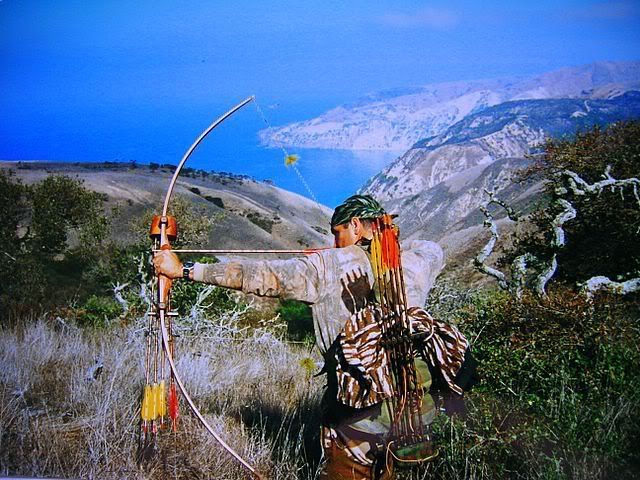
PS Nice pic’s
-
Thanks, King. You are right about the critical importance of consistent full draw, anchor point, etc. I have never suffered target panic on targets and can’t even conceive of this common problem of not being able to come to full draw, via some sort of internal pressure, with no more pressure than a target. But on live game I have had the problem over the years on occassion and pretty much have it whipped via practice and concentration. This was a special case and I probably should not have taken the shot, which doubtfully would have worked out were it not for the extra horsepower of the arrow setup. Thing was, with just a split second when the whirling bull was full broadside, my subconscious apparently told my arm there wasn’t time for a full draw. I don’t know. I do know I”d never have attempted it if the animal hadn’t been almost on top of me, feet not yards away. It was a bad shot choice under pressure of the last day of the hunt and proximitiy to the bull. But that stuff happens once in a while for many or most of us and can never be fully outgrown when circumstances combine in unexpected ways, at least in my case. All of which is to say that a clicker is a great tool under most circumstances but it wouldn’t have helped in this one. In the end, the elk pot roast we had last night was heaven. Cheers, dave
-
Dave,
That ‘hole’ in the scapular flat is precisely typical. Splits from hits in the ‘flat’ are rare; they come from hits neat the scapular head. Here are a couple more. Note the extreme similarity of hole size. No shaft drag there!
First pic is zebra scapula. Note single-bevel ‘hole’ (green arrow), bone chip (black arrow) made by 190 Grizzly and hole left by double-bevel Howard Hill BH (blue arrow).
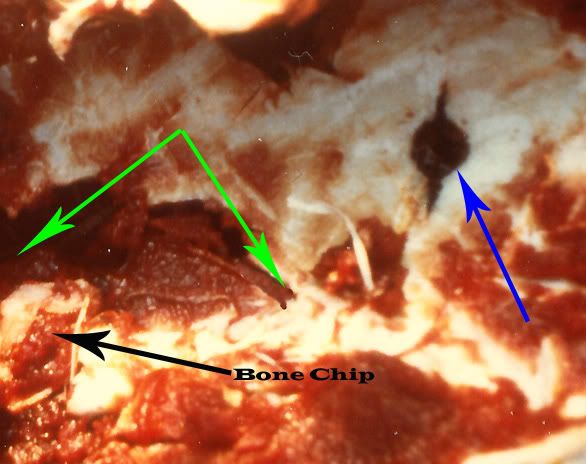
Second pic is from David Messiaen’s Mouflon; another 190 Grizzly.
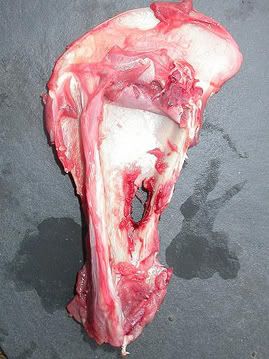
Consistency of performance on the scapular flat.
Ed
-
Right on Dave, I’m glade you understood what I was trying to say.
Dave I appreciate your honesty on the shot and what was happening and how your equipment was set up for the “WHAT IF” rather than the perfect broadside, standing flatfooted shot.
-
-
AuthorPosts
- You must be logged in to reply to this topic.

